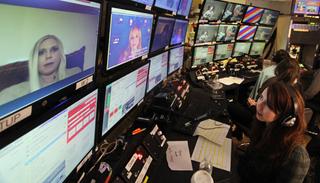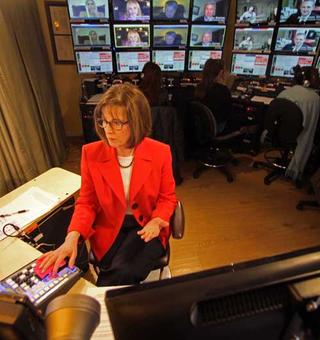Anticipating the Next Generation of TV Call-In Shows
NEW YORK—Media Executive and Inventor Tom Wolzien had an idea for a new type of TV talk show that includes the ability for fans around the world to call in and participate. The idea is a Video Call Center (VCC) that allows producers to create television programs from multiple web video callers using systems such as Skype. So he applied for a patent and on July 1, the US Patent and Trademark Office recently issued him U.S. Patent #8,767,031.
The patent relates to technology and production systems for the efficient creation of TV's version of talk radio, but where viewers can see the callers, and whatever the callers want to show. The real novelty is that TV and cable networks could produce live shows centered on video callers that puts the on-camera host in complete control, without the need for a traditional control room (unheard of in TV, but typical in caller-based talk radio).

The Video Call Center allows producers to create television programs from multiple web video callers using systems such as Skype. "The patented Video Call Center technology allows the first new TV content genre since the inception of reality TV, two decades ago," said Wolzien, in a statement. "VCC is right at the intersection of social and mass media, TV and the web. What's unique is that the system doesn't just handle a single IP video call, but it's designed to handle multiple video calls simultaneously, each with the power of its own computer—essential for any live caller-based TV program."
The live shows can be produced with a total of five or six production and technical personnel: the host, a show producer, two call screeners, and one or two video/IT technicians .Operating costs for VCC are low for a live TV show since there are no content costs for the video callers, and staffing is kept to a minimum.
Wolzien said VCC technology works in a production facility that encompasses inbound, studio, and outbound technologies. The VCC technology allows the TV host to take the reins of a show without the normal control room, something unheard of in TV, but typical in caller-based talk radio. Automation assists the video switching and audio mixing so that the host can focus on the content of the conversation without having to worry about changing cameras. VCC handles multiple video callers at the same time, with many screened and simultaneously ready for the TV host to select for air.
"The ability to produce fresh, always-new content not only resets the bar on live TV costs but actually becomes competitive with reruns," Wolzien said. "This works economically in any time slot, and that means it opens up live content for secondary networks that are increasingly being criticized by cable and satellite distributors for not providing much original content."
Since early 2013, Wolzien and his team have been creating laboratory shows under the TalkCenterAmerica name (which serves as a test bed for developing content and working out technical and production system issues). To date, nearly 50 TV content hours of TalkCenterAmerica shows have been produced live to the web with topics including politics, veterans, crime and justice, sports, comedy, garage bands, and even cats.
Get the TV Tech Newsletter
The professional video industry's #1 source for news, trends and product and tech information. Sign up below.

Automation assists the video switching and audio mixing so that the host can focus on the content of the conversation without having to worry about changing cameras. Wolzien wrote the first generation of software and built the inventor's prototype. Development of the second generation has been overseen by Larry Thaler, an NBC veteran and President/CEO of Positive Flux LLC, a veteran systems designer and integrator that has worked with the likes of ClearChannel, HBO LAG, Hearst Interactive Media, NBC Universal, NBC Sports, and Univision.
"When we saw Video Call Center, we immediately recognized technology with the capacity to be a legitimate game-changer" said Thaler, "Live call-shows are the mainstay of talk radio, but have been too expensive and complex to be considered by most broadcasters. VCC leverages ingenious automation and user interface tools to strip out the burdens and put an entirely new category of content in the hands of broadcasters."
One of the key contributions of Positive Flux to the VCC system was the creation of an intelligent, adaptive scripting system that enables the on air host to drive the switching and mixing of visual sources with a single touch. This enables each show to have it's own look and feel, despite working without a technical crew.
"Hosts feel powerful when they use this technology," said Thaler.
"The experience of the Positive Flux team has been instrumental in turning our unique core technologies and fundamental vision into a practical solution that meets the budgetary and workflow requirements of our broadcast customers," said Wolzien.
Among a list of production and Internet switching technologies, the new VCC automated production solution is using integrated video production switchers from Broadcast Pix, taking advantage of are Broadcast Pix's application programming interface (API) and file-based macros to create this video-driven version of talk radio using Web-based video sources.
With VCC, the on-camera host produces the call-in show without a traditional control room. Broadcast Pix API and Fluent Macros allow the VCC software to provide the host with the ability to trigger sequences of individual key/shot combinations that can be modified based on available callers. Using Skype and similar technologies on various devices, multiple Web video callers can connect to the show. Viewers can see the callers and whatever the callers want to show. Proprietary CAT Caller Acquisition Software assists screeners with incoming calls, audio metering, video cropping and conversion, and return video. In addition, a patented Text Overlay superimposes caller names and locations over the caller's picture at the screener's position and remains on-screen when the caller is added to the live production.
Wolzien holds several patents that cross between the Internet and mass media. He is a 45 year veteran of local, broadcast network, and cable television, was a highly ranked Wall Street analyst, and most recently a consultant working with senior managements of large media organizations through his company, Wolzien LLC. He spent 15 years at NBC, rising from White House producer to show runner at NBC News, and then to corporate business development. He spent 14 years as the Senior Media Analyst at Sanford C. Bernstein (now Alliance/Bernstein). He is also the lead independent director for TiVo, Inc.
"Video Call Center technology is a breakthrough in TV content creation, putting live production within the budget and technical capability of any broadcast operator," said Wolzien. "We enable broadcasters to replace stale, reruns with compelling, dynamic, live and original content that engages viewers and advertisers."
There's been no word yet on when the technology will go live.
